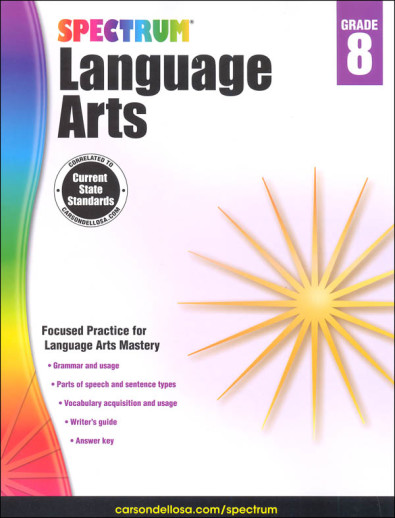We use cookies to make your experience better. To comply with the new e-Privacy directive, we need to ask for your consent to set the cookies. Learn more.
Spectrum Language Arts 2015 Grade 8
This consumable worktext covers mechanics (capitalization, punctuation), usage (subject/verb agreement, troublesome words, plurals, possessives, etc.), and grammar (parts of speech, types of sentences) in approximately 50 two-page lessons plus periodic reviews. Lessons include brief instructional material plus practice exercises. A Writer's Handbook section with ten writing lessons that cover the writing process and various forms of writing is also included. Answer key is found in the back. The colorful books have a visually appealing format, with wide lines, engaging graphics, and a good amount of white space. 198 pgs, pb.
For the most part the newest edition (2015 copyright) is essentially the same as the older edition (2007 copyright). The tables of content are identical but very occasionally wording on an exercise page has been changed, seemingly to raise the reading level of the material. These hefty worktexts cover mechanics (capitalization, punctuation), usage, and grammar in approximately 50 two-page lessons plus periodic reviews. A Writer's Handbook section with ten writing lessons is also included, along with complete answer keys. These are comprehensive but inexpensive texts that can be used alongside Writing Strands or another writing program for a complete English course. The series features a revised sequence of skills and more nonfiction activities.
The two newest additions to this series are kindergarten and first grade and are aligned to state & national standards. Written at a grade appropriate level, the kindergarten workbook covers parts of speech (nouns, verbs, pronouns), capitalization (I, names, first word in a sentence), punctuation (periods & question marks), while still working on the alphabet, letter sounds, and more. Chapter 5 is a 'writer's guide' in which students will practice using telling words, proofreading, and writing a friendly letter. The first grade book covers parts of speech (common & proper nouns, verbs, pronouns, adjectives), types of sentences (statements, questions, exclamations, combining sentences), capitalization (first word in a sentence, I, names, places, days, months), punctuation (period, question mark, commas in dates/cities & states, apostrophes), subject-verb agreement, contractions, irregular & past tense verbs, plurals, pronouns I and me, synonyms, antonyms and more. The 'writer's guide' for grade one takes students through the steps of writing a paper - planning, writing, revising, proofreading, publishing, and writing a friendly letter. The answer key is found at the back of the books. These books are done in a visually appealing format, with wide lines, cute graphics, and a good amount of white space so they aren't visually overwhelming for young learners.
| Product Format: | Paperback |
|---|---|
| Grade: | 8 |
| Brand: | Spectrum |
| ISBN: | 9781483812120 |
| Length in Inches: | 10.75 |
| Width in Inches: | 8.5 |
| Height in Inches: | 0.5 |
| Weight in Pounds: | 0.85 |


I have a set of Spectrum English Workbooks Grades 1 - 8, because I' am a Special Education Teacher here at Highland High School, in Albuquerque, N.M.
Looks like a cost-effective tool for Language Arts.
This is the curriculum our family uses.
I have liked using the Spectum Series. Trying the Language Arts for the first time